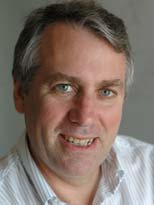
Kerry Emanuel, MIT professor of meteorology, ignited a storm of worldwide media attention in 2005, when he published a paper in Nature linking global warming with increased hurricane intensity. The paper appeared just three weeks before hurricane Katrina devastated New Orleans, and the reported connection with climate change spawned big headlines.
In the years since, a number of scientific papers have appeared on the subject, some supporting Emanuel’s original findings, some disputing them, and a vigorous debate has raged on. So it’s no surprise that when Emanuel published another paper on the subject earlier this month, it quickly attracted attention.
While the first paper looked at the record of actual hurricanes for the last 30 years, the new one used computer models to look both backward in time and ahead at what could happen two centuries from now. The results were a bit more complex than the earlier ones. Below is an interview with him about the subject and the media coverage.
Q: How did the new results differ from your 2005 paper?
A: I got results with a mixed message. On the one hand, it pretty much backed up the conclusions from what had happened earlier: There was a big increase in storm power. On the other hand, when that technique was used to go forward in time, the increase in hurricane power was much more modest. Although we get variations from one model to another [of the seven global circulation models used in this study], even the greatest increases were no more than what we’ve already seen. So there’s a dichotomy — what you see going into the future is not nearly as dramatic as what you would get if you just extrapolate from the past.
Q: How do you interpret that discrepancy?
A: First, it might be because the past had little to do with climate change. Second, it might be because there’s a discrepancy in the model. Or third, less likely, the climate may be different in a rapidly changing world than in one that has equilibrated. I don’t have a strong bias as to which one of these is responsible.
Q: What does this say about the connection between global warming and hurricane power?
A: Often these increases in hurricane power, thanks largely to my paper, are seen as directly related to global warming. But it should be seen as more complex than that.
Q: How much confidence do you have in the new method used in this paper?
A: The technique pretty much verifies what we see in nature. It checks out well when we apply past data — it predicts hurricane activity that’s pretty consonant with what we see. We get about the right number and magnitude of hurricanes. We’re inferring the hurricanes from the climate data. That means that the technique works.
Q: How do you feel about the media coverage of the new paper?
A: I thought [the Houston Chronicle story] wasn’t bad except for the title [which was “Hurricane expert reconsiders global warming’s impact”]. The actual content was okay. In other cases, the people you expect to put a spin on it, put a spin on it. Skeptics’ blogs reported that I’d reversed my position. Other blogs latched onto the fact that we’re still predicting a very substantial increase. There’s a lot to spin.
How do you write a paper that you know could be spun both ways? You just put out a paper that lays it out as best you can.
Q: Were you surprised by the reaction?
A: It is treacherous. Most of what I publish is not subject to public scrutiny; I’m writing for fellow scientists. But in this charged atmosphere [on global warming], most of what you write gets dissected by people outside the community.
[The Chronicle story] was clever to point out that people who are crowing [over the claim of a reversal] are in effect crowing over the same climate models that they spend most of their time criticizing.
When Fox News called me up, they started from the premise that I’d reversed myself. I said that’s really not true, it’s just that things are more complicated. It was a very short interview. I guess that’s what happens when people don’t spin things the way they think.
Q: Where does this research go from here?
A: The first thing we’re going to try to do is to try to figure out why the simulation of the last 25 years did what it did. Was it the temperature changing, the wind shear changing, the humidity changing — what was it that caused the increase? Then, we can run the models forward [with different conditions] to see what’s responsible for what. I think we will be able to figure out why the future effects differ from what’s happened in the recent past. That’s what everyone wants to know — the ‘why.’
Also, we can look at more regional effects. All we looked at was basin-wide effects. There could be differences — for example, hurricanes could be more easily steered offshore, or more preferentially steered onshore. Even if the basin-wide effects are the same, you can get regional differences that could be important. The technique can do that, but we haven’t looked at that yet.